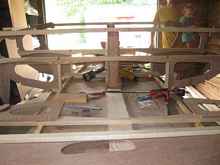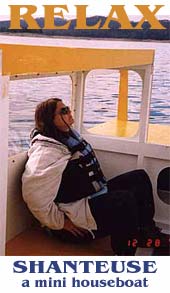|
- How We Picked Our John Welsford Navigator
When my wife, Maria, and I decided to build a sailboat. We had
to first decide what boat to build. We came up with a list of
rather exacting requirements. It needs to be trailerable. It needs
to be built on a modest income. It needs to be built and stored
in our single-car garage. It needs to carry our entire family.
It needs to be pretty. (My wife was particularly adamant about
this point.) It definitely needs to be novice friendly. My previous
building experience was a kit RC sailplane. This would be a much
bigger project.
The first challenge was our family. We currently have three children,
ages 1,3 and 5. The boat needs to be able to carry all of us and
maybe a friend as well.
A second challenge was the garage: 12 x 20.5 feet from the walls
to the door. This would be our boat building and storage space;
anything we built simply had to fit here. No exceptions.
 |
Our building space. That’s all, folks. |
The third challenge was associated with the second: finances.
Fortunately, small boats generally cost less than big boats, so
the space constraints went hand in hand with the checkbook constraints.
The third challenge was mast height. We wanted to store the mast
in the garage with the boat. Realistically, this ruled out any
Bermuda-rigged boat, and consequently, almost any used sailboat
(certainly the least expensive option for acquiring a boat). Gaff
and lug rigged boats can have masts not much longer than the hull,
so we started looking in that direction. Besides, the older rigs
just look classy.
This brings us to the fourth challenge. We wanted a pretty boat,
a unique boat, a boat that would turn heads as it goes cruising
across a lake. This means different things to different people,
but to us it translates into a lapstrake hull and a traditional-looking
sail rig, a little tumblehome and some curves. As simple to build
and practical as they are, we really didn’t want a boxy-looking
boat. No single-chine skiff, or plastic barge thank-you-very-much.
Finally, we were looking for something forgiving. Confession
time: I have never sailed. My wife has ridden on a sailboat a
couple times as a kid. Both of us have gone canoeing. We learn
quickly, but for now, we’re as green as pond water on this
point. Therefore, it needs to be more forgiveness-based than performance-based.
This criterion eliminated a LOT of other boats. Anything designed
for sail and oar is necessarily a bit tender under sail (or so
research indicates). We don’t want to be turning heads,
as people wonder what the Coast Guard is doing in Ohio, retrieving
a family of water-logged landlubbers and their overturned boat!
After pouring over designs by Iain Oughtred, Paul
Fisher, Arch Davis and Michael
Storer, we took a closer look at John
Welsford’s boats. Pathfinder
looked promising, but a little tight in the garage. So we figured
out international time zones, called John and he directed us to
Pathfinder’s little brother, Navigator.
At his suggestion, it was time to look a bit closer at Navigator.
The boat is only 15 feet long. As a result it should fit in the
garage quite comfortably, both in construction and afterwards,
on a trailer. We won’t even have to unmount the bowsprit.
 |
The bottom panel on the building frame, with
the stem mocked up. It will certainly fit. Once the bulkheads
are installed, the beam will roughly double. |
The Navigator can be built with two different sail rigs. The
original rig was a racing sloop. The other rig is a lug yawl.
This rig has a mizzen mast just forward of the transom (about
an inch). As a result of this, the main mast is shifted forward
to less than 4 feet behind the prow. This gives us a cockpit over
10 feet long, allowing space for all our children in the boat
without undue ‘coziness.’ As much as they love each
other, I know mischief increases with proximity.
 |
This “boat” would be WAY too small. |
The lug yawl rig also fulfills our mast length requirement admirably.
The main mast is just under 14 feet, and the mizzen is even shorter.
These should be very easy to transport and store. The yard and
both sprit booms are equally manageable in length. The boat uses
a bowsprit to allow the sailplan to extend forward of the stem,
but the bowsprit should very neatly overlap the tongue of a trailer.
There is also a bumpkin to sheet the mizzen, but that is easily
removed for transport or storage along with the rudder.
Finally, Navigator, especially with the lug yawl rig, is a very
attractive little boat. Maria loves the pointy bits sticking out
of both ends. I like the practicality and quirkiness of the standing
lug main, especially with its sprit boom. Who can resist a line
called a snotter (used for tensioning a sprit)?
After doing further research, I have discovered a number of other
interesting tidbits about our boat. Over 600 sets of plans have
been sold to date, and no small number have been finished. There
are a number of very well done build logs on the internet, in
varying stages of completion. John Welsford has an active Yahoo
group, where he graciously answers questions from
experts and novices alike (I fall very firmly into the latter
category). Many first-time builders have built her successfully.
So far, this first-time boatbuilder hasn’t run afoul. We
have the bottom panel up, have mounted the centerboard trunk and
are just starting to erect the bulkheads. Ask back in another
year or two and we’ll let you know how she sails!
 |
Progress to date: so far, so good! |
*****

|



